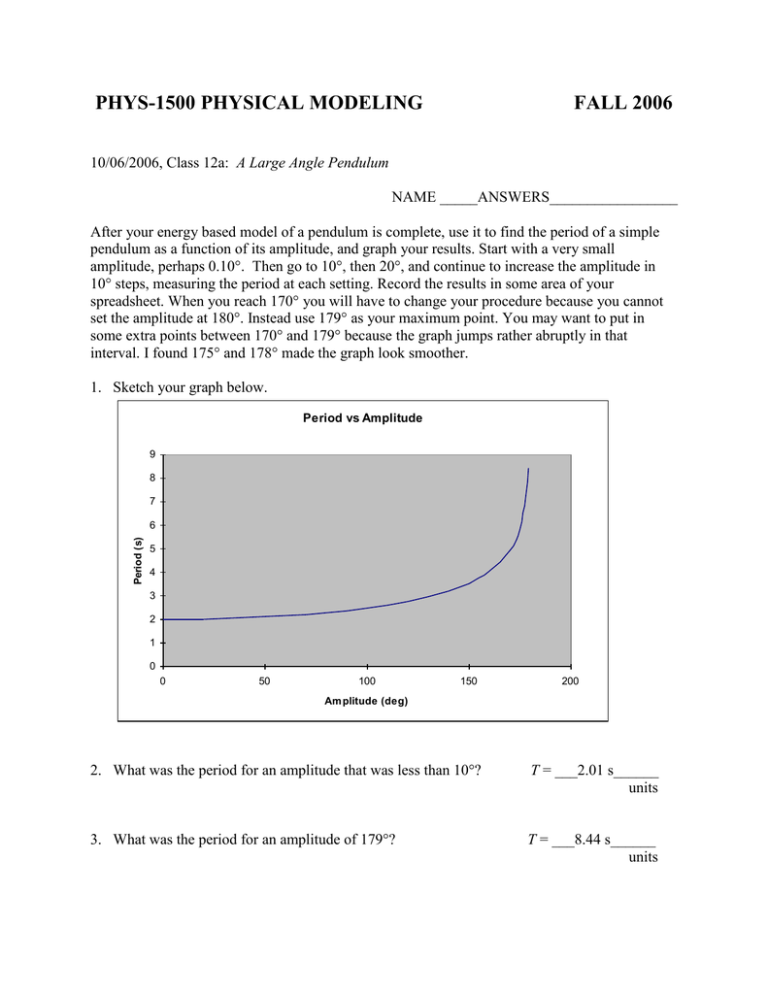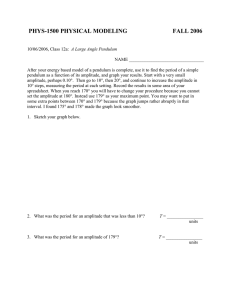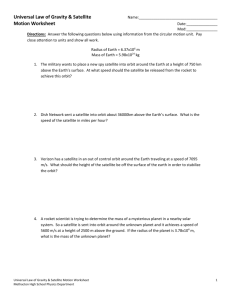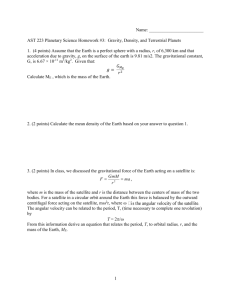PHYS-1500 PHYSICAL MODELING ...
advertisement

PHYS-1500 PHYSICAL MODELING FALL 2006 10/06/2006, Class 12a: A Large Angle Pendulum NAME _____ANSWERS_________________ After your energy based model of a pendulum is complete, use it to find the period of a simple pendulum as a function of its amplitude, and graph your results. Start with a very small amplitude, perhaps 0.10°. Then go to 10°, then 20°, and continue to increase the amplitude in 10° steps, measuring the period at each setting. Record the results in some area of your spreadsheet. When you reach 170° you will have to change your procedure because you cannot set the amplitude at 180°. Instead use 179° as your maximum point. You may want to put in some extra points between 170° and 179° because the graph jumps rather abruptly in that interval. I found 175° and 178° made the graph look smoother. 1. Sketch your graph below. Period vs Amplitude 9 8 7 Period (s) 6 5 4 3 2 1 0 0 50 100 150 200 Am plitude (deg) 2. What was the period for an amplitude that was less than 10°? T = ___2.01 s______ units 3. What was the period for an amplitude of 179°? T = ___8.44 s______ units Class 12b: A Falling Satellite A NASA administrator wants a new communications satellite placed in a synchronous orbit. Unfortunately, he carelessly tells a new employee to program the launch vehicle to put the satellite in a "stationary orbit". The new employee (not a Rensselaer graduate) thinks the satellite will stay up, even if it has zero velocity, as long as it is placed at the correct altitude. In a handbook, he finds that communications satellites, of the type being launched, should be placed in orbits of radius R = 4.22 × 107 m. Therefore, he programs the launch vehicle to carry the satellite to a point that distance from the center of Earth and leave it there, at rest (with v = 0). Naturally, it will fall straight to the surface of Earth. You will investigate the details of its fall. 1. Enter the expression for the satellite's velocity, v, as a function of its distance from the center of Earth, r, into your spreadsheet together with the following numerical values for constants that are needed in this problem. G = 6.67 × 10-11 N·m²/kg² The gravitational constant in SI units 24 M = 5.98 × 10 kg The mass of Earth in kg R = 4.22 × 107 m The radius of the "orbit" in meters 6 RE = 6.37 × 10 m The radius of Earth in meters 2. Plot graphs of the satellite's velocity, v, as a function of its distance from the center of Earth, r, and also as a function of time, t, as it falls from its starting radius until it hits Earth. Sketch the graphs below. Speed vs Distance 0 0 10000000 20000000 30000000 -2000 v (m/s) -4000 -6000 -8000 -10000 -12000 r (m ) 40000000 50000000 Speed vs Time 0 0 2000 4000 6000 8000 10000 12000 14000 16000 -2000 v (m/s) -4000 -6000 -8000 -10000 -12000 t (s) 3. With what speed will the satellite hit Earth? v = ___10311 m/s___ _____ units 4. How long after the satellite is placed in "orbit" will it crash into Earth? Since v = dr/dt , the time the satellite takes to fall dr is, dt = dr/v where v is the expression that was calculated in part 2. Therefore, the time it takes to fall from "orbit" can be calculated by adding together all the dt's, in other words, integrate. The total time is given by, R dr t . R v In this expression, RE is the radius of Earth, and R is the radius of the "orbit". E (Express your answer in convenient units. If the time is greater than 60 seconds but less than one hour, express it in minutes. If the time is greater than one hour but less than one day, express it in hours, etc.) t = __14870 s = 4.13 hr__ units 5. Why is it a good approximation to neglect the resistance of Earth's atmosphere in part 4? Most of the trip is above the atmosphere.




